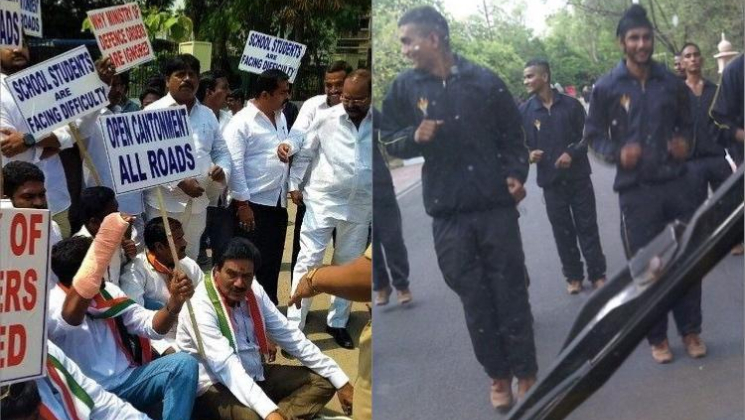Anyone who has respected the Indian army cannot help but be taken aback by the spectacle of political ‘Vijay Yatras that were seen in the last few days on some of our army cantonment roads. Cantonments are the bedrock of the Indian army. Even if you think that some cantonment roads needed to be opened up in wider public interest, televised images of lower-level BJP workers celebrating a ‘Vijay Yatra’ in Pune cantonment – swarming around on bikes and SUVs draped with party flags, distributing sweets and posing for self-congratulatory sound bites outside military gates – made for terrible optics.
At a time when army wives, families and veterans around the country are mobilising daily on social media against the Ministry Of Defense (MoD) statement on May 20, which ordered “all closed roads in the Cantonments to be reopened up immediately”, such political chest-thumping by karyakartas celebrating their little, local triumphs in the innermost bastions of the defence community sent out misleading signals. For a party that has built its political messaging on a muscular no-nonsense nationalism and the cult of the brave soldier, the contrast between the articulate, pleading army wives who have been leading the agitation against the reopening of cantonment roads versus the local vested interests who took to the cameras to celebrate what they saw as a victory against their own army, was too sharp to be missed.
Defense minister Nirmala Sitharaman rightly responded to the counter-pressure from within the defense community by meeting an army wives’ delegation with “an open mind” on May 31. The army has also clarified that the original decision to reopen closed roads in military areas was for “one month”, that it would thereafter “review the nature of traffic passing through these areas” and that a final decision will be taken after “feedback from Local Military Authorities (LMA)”. Whatever the final decision on the matter, it has once again re-focused attention on the growing tensions in the underlying social compact that has always underpinned the military-civilian relationship in the world’s largest democracy.
It is important to remember that arterial roads in many cantonments like Delhi, along with its adjoining Gopinath Bazar, have always been open to the wider public. Most of India’s 62 cantonments have always had large numbers of civilians (either from adjunct government departments or those providing services) residing within their geographic limits.
There have often been long-standing tussles over specific areas, but these have always been resolved at local levels. In Secunderabad cantonment, the government decided to close Gough Road to civilian traffic in December 2015. This followed an order by the Telangana and Andhra Pradesh high court on September 26, 2014. However, a specific request by the Chief Minister of Telangana meant that the decision was first deferred by six months and then a further four times till March 31, 2018, as MoS for defense Subhash Bhamre recently informed Parliament.
Issues like this meant that as far back as January 7, 2015, MoD issued instructions that “no public road, outside unit lines, in a Cantonment shall be closed by any authority other than a Cantonment Board, for any reasons other than security and without following the procedure laid down under Section 258 of the Cantonments Act, 2006.” As many as 24 roads nationally were opened up at the time. No one can reasonably argue with a structured case-by-case process of resolving legitimate disputes.
However, the reason this controversy blew up was because of the blanket directive on May 20, for “all closed roads” to be “reopened immediately”. From the attack on Kaluchak in 2002 to the Sunjuwan military base in early 2018, military families and installations have been repeatedly targeted in terror attacks as part of a deliberate strategy. There is also the issue of security for separated families, many of whom live in cantonment areas while soldiers serve in border areas. The blanket order (though certain stations were operationally exempt from it) raised several security concerns, as several veterans have pointed out. All armed forces, including in the US, UK and Australia, control access to their military garrison areas for security reasons.
At a deeper level, our cantonments were largely created by the British who deliberately kept army garrisons outside cities. The military was designed to be outside of society, precisely to keep it at arm’s length from the many problems of society. As our cities have grown, most of these cantonments find themselves engulfed by them, leading to civil-military problems that the roads access issue signifies.
Either, we create new military areas or we as citizens agree to put up with reasonable security measures. For example, Delhi Metro has ensured that only those with proper ID needed to enter a cantonment area are authorised to get off at the Shankar Vihar station on its new Magenta line, as it falls inside a secure location.
Finally, cantonment boards are currently led by serving army officers and comprise civilian bureaucrats as well as elected officials. Defence lands are a prize commodity. MoD data show that as much as 9,980 acres of its lands nationwide have been encroached so far. With colonies coming up along defense lands, local landed interests and elected representatives on boards drove some of the pressure for opening up defense roads.

